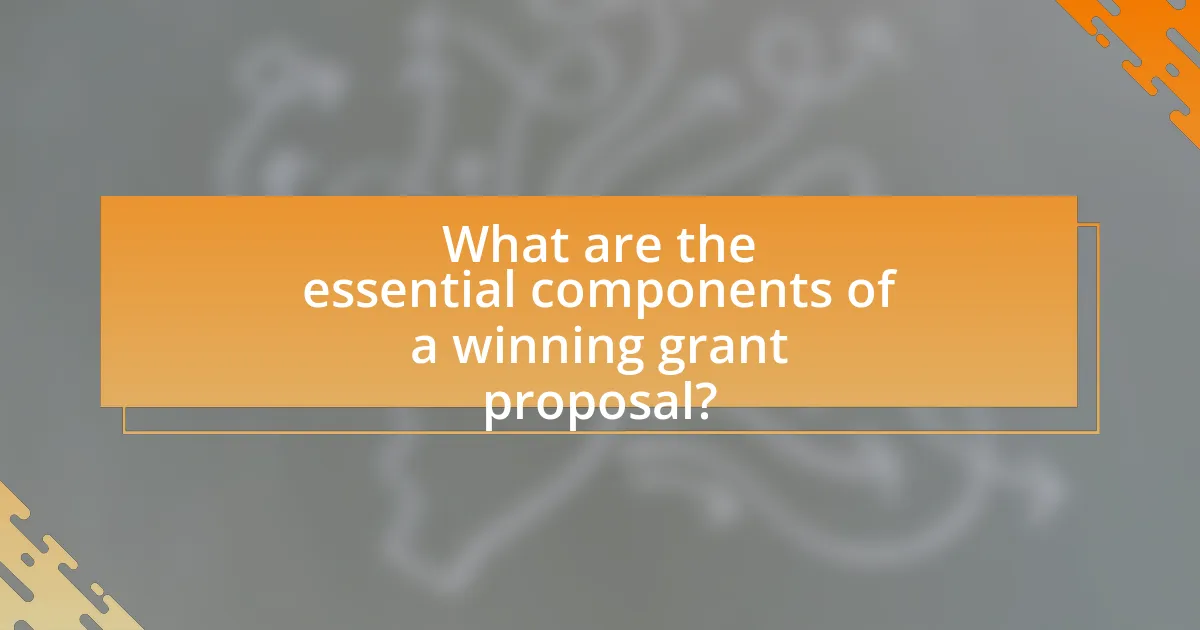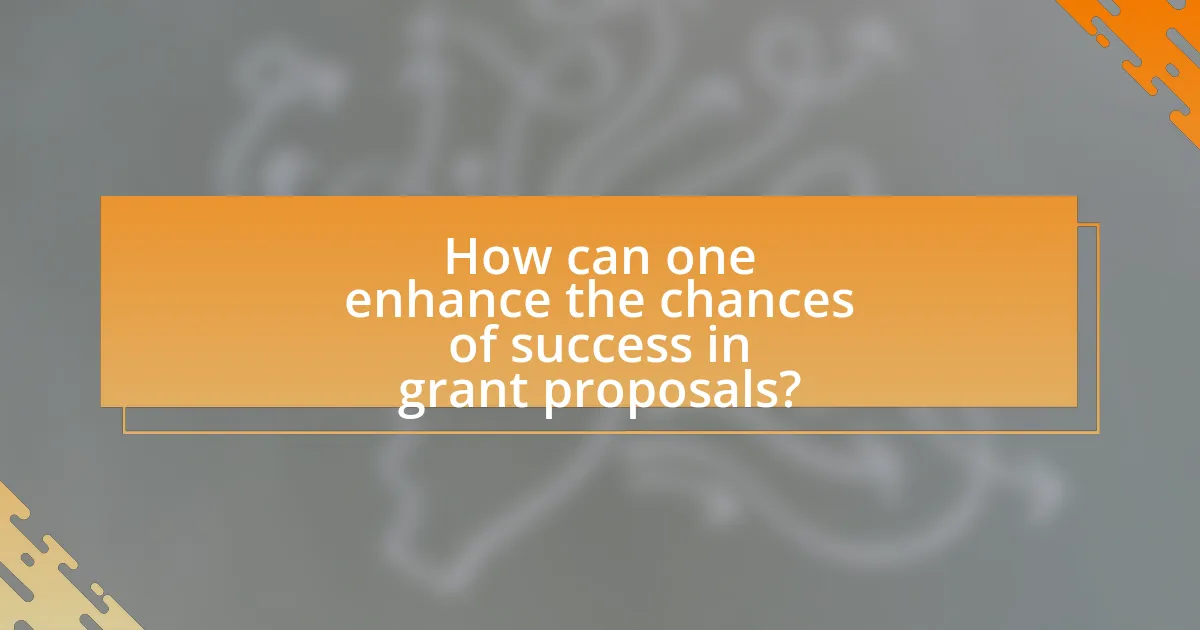Grant proposals for doctoral research are formal requests for funding that outline research objectives, methodologies, significance, and budgets. This article provides a comprehensive guide on writing effective grant proposals, highlighting the key elements that contribute to success, such as a compelling narrative, alignment with funding agency priorities, and a well-defined methodology. It also discusses the importance of understanding funding agencies, common pitfalls to avoid, and best practices for enhancing proposal clarity and persuasiveness. By following these guidelines, researchers can improve their chances of securing financial support for their doctoral research projects.

What are Grant Proposals for Doctoral Research?
Grant proposals for doctoral research are formal documents that request funding to support a specific research project undertaken by a doctoral candidate. These proposals typically outline the research objectives, methodology, significance, and budget, demonstrating the project’s feasibility and potential impact. Successful grant proposals often include a literature review, a detailed timeline, and a clear explanation of how the research contributes to the field, thereby justifying the need for financial support.
How do grant proposals differ from other types of proposals?
Grant proposals differ from other types of proposals primarily in their purpose and funding source. While general proposals may seek approval for projects or ideas from various stakeholders, grant proposals specifically request funding from organizations, such as government agencies or foundations, to support research or projects. This distinction is crucial as grant proposals must adhere to specific guidelines set by funding bodies, including detailed budgets, project timelines, and measurable outcomes, which are not always required in other proposal types. Additionally, grant proposals often emphasize the significance of the research and its potential impact, aligning with the funding organization’s mission, which is less common in other proposals.
What key elements define a successful grant proposal?
A successful grant proposal is defined by several key elements: a clear and compelling project narrative, a well-defined budget, alignment with the funding agency’s priorities, and a strong evaluation plan. The project narrative articulates the significance, objectives, and methodology of the research, ensuring it addresses a specific problem or gap in knowledge. A well-defined budget provides a detailed breakdown of costs, demonstrating fiscal responsibility and feasibility. Alignment with the funding agency’s priorities ensures that the proposal resonates with the agency’s mission and goals, increasing the likelihood of funding. Lastly, a strong evaluation plan outlines how the project’s outcomes will be measured and assessed, providing accountability and demonstrating the project’s potential impact. These elements collectively enhance the proposal’s credibility and persuasiveness, making it more likely to secure funding.
Why is understanding the funding agency important?
Understanding the funding agency is crucial because it informs researchers about the agency’s priorities, guidelines, and evaluation criteria. This knowledge enables researchers to tailor their proposals to align with the agency’s mission and funding objectives, increasing the likelihood of securing financial support. For instance, the National Institutes of Health (NIH) emphasizes health-related research, while the National Science Foundation (NSF) focuses on scientific advancement. By comprehending these distinctions, researchers can craft proposals that resonate with the specific interests of the funding agency, thereby enhancing their chances of success.
What is the significance of grant proposals in doctoral research?
Grant proposals are significant in doctoral research as they provide essential funding and resources necessary for conducting comprehensive studies. These proposals outline the research objectives, methodologies, and expected outcomes, which are critical for securing financial support from institutions, government agencies, or private organizations. According to the National Science Foundation, successful grant applications can significantly enhance the research capabilities of doctoral candidates, enabling them to access advanced tools, collaborate with experts, and disseminate their findings effectively. Thus, grant proposals not only facilitate the financial aspect of research but also contribute to the overall quality and impact of doctoral studies.
How do grant proposals impact research funding opportunities?
Grant proposals significantly influence research funding opportunities by serving as formal requests for financial support, detailing the research objectives, methodologies, and anticipated outcomes. A well-crafted grant proposal increases the likelihood of securing funding, as it demonstrates the researcher’s capability and the project’s relevance to funding agencies’ priorities. For instance, the National Science Foundation reports that successful proposals often align closely with their strategic goals, leading to higher approval rates. Thus, the quality and clarity of grant proposals directly correlate with the availability of funding for research projects.
What role do grant proposals play in academic advancement?
Grant proposals are essential for academic advancement as they secure funding for research projects, enabling scholars to pursue innovative studies and contribute to their fields. By obtaining grants, researchers can access resources, collaborate with other experts, and enhance their academic profiles through published findings. According to the National Science Foundation, funded research projects often lead to increased visibility and credibility within the academic community, which can result in further opportunities for collaboration and career progression.

What are the essential components of a winning grant proposal?
A winning grant proposal includes several essential components: a clear and compelling narrative, a well-defined budget, a strong statement of need, specific goals and objectives, a detailed methodology, and an evaluation plan. The narrative articulates the significance of the research and its potential impact, while the budget outlines the financial requirements necessary to achieve the proposed work. The statement of need demonstrates the relevance of the research problem, and the goals and objectives provide measurable outcomes. The methodology details the approach to be taken, ensuring feasibility, and the evaluation plan outlines how success will be measured. These components collectively enhance the proposal’s clarity and persuasiveness, increasing the likelihood of funding.
How should the research problem be articulated in the proposal?
The research problem should be articulated clearly and concisely in the proposal to establish its significance and relevance. This involves defining the problem, explaining its context, and outlining its implications for the field. A well-articulated research problem includes specific details that highlight the gap in existing knowledge, supported by relevant literature or statistics that demonstrate the need for the research. For instance, a study by Creswell (2014) emphasizes that a clearly defined research problem enhances the proposal’s credibility and persuasiveness, making it more likely to attract funding.
What makes a research problem compelling to reviewers?
A research problem is compelling to reviewers when it addresses a significant gap in existing knowledge and demonstrates potential for impactful contributions to the field. Reviewers prioritize problems that are relevant, timely, and aligned with current trends or pressing societal issues, as these factors enhance the likelihood of the research yielding valuable insights. For instance, a study focusing on climate change’s effects on public health can attract attention due to its urgency and relevance. Additionally, a well-defined research problem that articulates clear objectives and methodologies increases its appeal, as it shows the researcher’s preparedness and understanding of the subject matter.
How can one effectively demonstrate the significance of the research problem?
To effectively demonstrate the significance of the research problem, one should clearly articulate its relevance to existing literature and societal needs. This involves identifying gaps in current knowledge and explaining how addressing these gaps can lead to advancements in the field or improvements in practice. For instance, a study published in the Journal of Research in Science Teaching highlighted that research addressing educational disparities can significantly impact policy changes, thereby illustrating the broader implications of the research problem. By providing specific examples and citing relevant studies, researchers can substantiate the importance of their work and its potential contributions to knowledge and society.
What is the importance of a well-defined research methodology?
A well-defined research methodology is crucial because it provides a structured approach to conducting research, ensuring reliability and validity of results. This structured approach allows researchers to clearly outline their methods, which facilitates reproducibility and transparency in the research process. For instance, a study published in the “Journal of Research Practice” by David A. McMillan emphasizes that a clear methodology enhances the credibility of research findings and aids in peer review. Furthermore, a well-defined methodology helps in effectively addressing research questions, thereby increasing the likelihood of securing funding for doctoral research proposals.
How can one ensure the methodology aligns with the research objectives?
To ensure the methodology aligns with the research objectives, one must clearly define the research objectives first and then select a methodology that directly addresses those objectives. This alignment can be achieved by conducting a thorough literature review to identify established methods that have successfully addressed similar objectives in past research. For instance, if the objective is to explore the impact of a specific intervention, employing a quantitative methodology with appropriate statistical analysis can provide measurable outcomes that directly relate to the objective. Additionally, pilot testing the methodology can help refine the approach and ensure it effectively captures the necessary data to meet the research goals.
What common pitfalls should be avoided in the methodology section?
Common pitfalls to avoid in the methodology section include lack of clarity, insufficient detail, and failure to justify choices. Clarity is essential; vague descriptions can lead to misunderstandings about the research process. Insufficient detail can prevent reviewers from assessing the feasibility and rigor of the proposed methods. Additionally, failing to justify methodological choices undermines the credibility of the research design. For instance, a study that does not explain why a specific sampling method was chosen may raise concerns about its validity. These pitfalls can significantly weaken a grant proposal’s chances of success.

How can one enhance the chances of success in grant proposals?
To enhance the chances of success in grant proposals, one should focus on clearly articulating the project’s significance, objectives, and methodology. A well-defined problem statement that aligns with the funding agency’s priorities increases the likelihood of approval. Research indicates that proposals with specific, measurable outcomes and a detailed budget are more successful; for instance, a study by the National Science Foundation found that clarity in objectives and alignment with funding goals significantly boosts funding rates. Additionally, incorporating feedback from peers and mentors can refine the proposal, ensuring it meets high standards and addresses potential reviewer concerns effectively.
What strategies can be employed to tailor proposals to specific funding agencies?
To tailor proposals to specific funding agencies, researchers should first thoroughly analyze the agency’s mission, priorities, and funding criteria. This understanding allows for alignment of the proposal’s objectives with the agency’s goals, increasing the likelihood of approval. For instance, if an agency prioritizes innovative solutions to climate change, the proposal should emphasize how the research addresses this issue directly. Additionally, incorporating specific language and terminology used by the agency can enhance relevance and demonstrate familiarity with their focus areas. Research shows that proposals that closely match the funder’s interests have a higher success rate, as evidenced by a study from the National Science Foundation indicating that alignment with funding priorities can increase approval rates by up to 30%.
How can one effectively research the priorities of funding agencies?
To effectively research the priorities of funding agencies, one should analyze their official websites, review funding announcements, and examine previously funded projects. Funding agencies typically publish their strategic goals, areas of interest, and eligibility criteria on their websites, which serve as primary resources for understanding their priorities. Additionally, reviewing funding announcements provides insights into specific topics and themes that agencies are currently prioritizing. Analyzing previously funded projects allows researchers to identify trends and preferences in funding decisions, thereby aligning their proposals with the agency’s interests. This methodical approach ensures that researchers can tailor their grant proposals to meet the specific priorities of funding agencies.
What are the best practices for aligning research goals with funding agency missions?
The best practices for aligning research goals with funding agency missions include thoroughly understanding the agency’s priorities, tailoring proposals to reflect those priorities, and demonstrating how the research addresses specific agency objectives. Researchers should analyze the funding agency’s mission statements, strategic plans, and previously funded projects to identify key themes and areas of interest. By explicitly linking research objectives to these themes in grant proposals, researchers can enhance the likelihood of funding success. For instance, the National Institutes of Health emphasizes health outcomes, so proposals that clearly articulate how the research will improve public health are more likely to receive funding.
What common mistakes should be avoided in grant proposals?
Common mistakes to avoid in grant proposals include lack of clarity, insufficient detail, and failure to follow guidelines. Clarity is essential; proposals should clearly articulate the research objectives and significance. Insufficient detail can lead to misunderstandings about the project’s scope and methodology, which may result in rejection. Additionally, not adhering to the specific guidelines set by the funding agency can disqualify a proposal, as each agency has unique requirements regarding format, length, and content. According to a study by the National Institutes of Health, proposals that closely follow submission guidelines have a higher success rate, emphasizing the importance of compliance in the grant application process.
How can vague language undermine a proposal’s effectiveness?
Vague language can undermine a proposal’s effectiveness by creating ambiguity that confuses reviewers and detracts from the proposal’s clarity. When a proposal lacks specific details, it fails to convey the significance of the research, the methodology, and the expected outcomes, leading to misunderstandings about the project’s goals. Research indicates that proposals with clear, precise language are more likely to receive funding; for instance, a study by the National Science Foundation found that clarity in writing significantly correlates with higher success rates in grant applications. Therefore, using specific language enhances the proposal’s persuasiveness and overall impact.
What are the consequences of failing to follow application guidelines?
Failing to follow application guidelines can result in disqualification from the grant review process. This occurs because adherence to guidelines is often a criterion for eligibility, and non-compliance can lead to automatic rejection of the proposal. For instance, the National Institutes of Health (NIH) states that proposals not meeting formatting and submission requirements will not be reviewed, emphasizing the importance of strict adherence to guidelines.
What practical tips can improve grant proposal writing?
To improve grant proposal writing, focus on clarity, specificity, and alignment with funding agency priorities. Clear writing ensures that reviewers easily understand the proposal’s objectives and significance. Specificity in outlining goals, methods, and expected outcomes enhances credibility and demonstrates thorough planning. Aligning the proposal with the funding agency’s mission and priorities increases the likelihood of approval, as it shows that the project addresses the agency’s interests. Research indicates that proposals that clearly articulate their relevance to funding priorities have a higher success rate, as evidenced by a study published in the Journal of Research Administration, which found that 70% of successful proposals effectively matched their objectives with funder goals.
How can one create a compelling narrative throughout the proposal?
To create a compelling narrative throughout the proposal, one should establish a clear and engaging storyline that connects the research problem, objectives, and significance. This involves articulating the research question in a way that resonates with the audience, using relatable language and examples to illustrate the impact of the research. Additionally, integrating personal motivation and the broader context of the research enhances emotional engagement, making the proposal more persuasive. Research indicates that narratives that include a clear beginning, middle, and end can significantly improve reader engagement and retention of information, as highlighted in studies on effective communication strategies in grant writing.
What role does feedback play in refining grant proposals?
Feedback plays a crucial role in refining grant proposals by providing insights that enhance clarity, coherence, and overall quality. When reviewers or peers evaluate a proposal, they identify strengths and weaknesses, allowing the author to address specific concerns and improve the proposal’s alignment with funding criteria. Research indicates that proposals incorporating feedback have a higher success rate; for instance, a study by the National Science Foundation found that proposals revised based on peer feedback were 30% more likely to receive funding. This iterative process of receiving and integrating feedback ultimately leads to stronger, more competitive grant applications.



